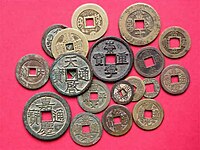User talk:AjaxSmack/Sandbox/Cash (Chinese coin)

A cash (Chinese: 方孔錢; pinyin: fāng kǒng qián; lit. 'square-holed money', 銅錢 tóng qián "copper money," or 銅錢 tóng bì "copper currency") was a type of coin of China and East Asia from the 2nd Century BC until the AD 20th century.
Terminology[edit]
The English term "cash" was derived from the Tamil kāsu, a South Indian monetary unit. The English word "cash", meaning "tangible currency", is an older word from Middle French caisse.[1]
There are a variety of Chinese terms for cash coins, usually descriptive and most commonly including the character qián (錢) meaning "money." Confusingly, Chinese qián is also a weight-derived currency denomination in Chinese called mace in English.
Manufacture[edit]

Traditionally, Chinese cash coins were cast in copper, brass or iron. In the mid 1800s, the coins were made of 3 parts copper and 2 parts lead.[2] Cast silver coins were periodically produced but are considerably rarer. Cast gold coins are also known to exist but are extremely rare.
History[edit]
Chinese cash coins originated from the barter of farming tools and agricultural surpluses. Around 1200 BC, smaller token spades, hoes, and knives began to be used to conduct smaller exchanges with the tokens later melted down to produce real farm implements. These tokens came to be used as media of exchange themselves and were known as spade money and knife money.[3]
As standard circular coins were developed following the unification of China by Qin Shi Huang, the most common formation was the round-shaped copper coin with a square or circular hole in the center, the prototypical cash. The hole enabled the coins to be strung together to create higher denominations, as was frequently done due to the coin's low value. The number of coins in a string of cash (yīguànqián 一貫錢) varied over time and place but was usually 1000. A string of 1000 cash was supposed to be equal in value to one tael of pure silver.[3] Paper money equivalents sometimes showed pictures of the appropriate number of cash coins strung together.
The Koreans, Japanese, and Vietnamese all cast their own copper cash in the latter part of the second millennium similar to those used by China.
The last cash coins were struck, not cast, in the reign of the Qing Xuantong Emperor shortly before the fall of the Empire in 1911. The coin continued to be used unofficially in China until the mid 20th century.
Inscriptions and denominations[edit]
The earliest standard denominations of cash coins were theoretically based on the weight of the coin and were as follows:
- 100 grains of millet = 1 zhū (銖)
- 24 zhū = 1 tael (liǎng 兩)
The most common denominations were the ½ tael (bànliǎng 半兩) and the 5 zhū (wǔ zhū 五銖) coins, the latter being the most common coin denomination in Chinese history.[3]
In AD 666, a new system of weights came into effect with the zhū being replaced by the mace (qián) with 10 mace equal to one tael. The mace denominations were so ubiquitous that the Chinese word qián came to be used a the generic word for money.[3] Other traditional Chinese units of measurement, smaller subdivisions of the tael, were also used as currency denominations for cash coins.
A great majority of cash coins had no denomination specifically designated but instead carried the issuing emperor's era name and a phrases such as tōngbǎo (通寶) meaning "general currency" or zhòngbǎo (重寶) meaning "precious currency."
Coins of the Qing Empire (1644-1911) generally carried the era name of the emperor and tōngbǎo on the obverse and the mint location where the coins were cast in Manchu and Chinese on the reverse.
References[edit]
- ^ Douglas Harper (2001). "Online Etymology Dictionary". Retrieved 2007-04-11.
{{cite web}}: Check date values in:|date=(help) - ^ Roberts, Edmund. [1837] (1837) Embassy to the Eastern Courts of Cochin-China, Siam, and Muscat: In the U.S. Sloop-of-war Peacock. Harper & Brothers. Harvard University archive. No ISBN Digitized.
- ^ a b c d Fredrik Schöth. Chinese Currency. Revised and edited by Virgil Hancock. Iola, WI, USA: Krause, 1965.
![]() This article incorporates text from this source, which is in the public domain. Country Studies. Federal Research Division.
This article incorporates text from this source, which is in the public domain. Country Studies. Federal Research Division.
External links[edit]
[[Category:Economic history of China]] [[Category:Ancient currencies]] [[Category:Medieval currencies]] [[Category:Modern obsolete currencies]]
